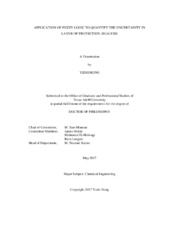| dc.contributor.advisor | Mannan, Sam | |
| dc.creator | Hong, Yizhi | |
| dc.date.accessioned | 2017-08-21T14:32:24Z | |
| dc.date.available | 2019-05-01T06:07:48Z | |
| dc.date.created | 2017-05 | |
| dc.date.issued | 2017-01-23 | |
| dc.date.submitted | May 2017 | |
| dc.identifier.uri | https://hdl.handle.net/1969.1/161293 | |
| dc.description.abstract | Layer of Protection Analysis (LOPA) is a widely used semi-quantitative risk assessment method. LOPA includes both frequency and consequence expressed in an order of magnitude approximation. Compared with Quantitative Risk Analysis (QRA), LOPA provides a simplified but less precise method to assess the effectiveness of protection layers and the risk reduction of an incident scenario. The outcome frequency and consequence of LOPA are intended to be conservative, which makes the risk overestimated. A high risk indicates the requirement of additional Independent Protection Layers (IPLs), which calls for higher installation and maintenance costs. There are different sources and types of uncertainty in LOPA model that need to be identified and quantified.
Fuzzy logic is a method to deal with systems that are too complex or not clearly defined. Using fuzzy arithmetic, imperfect data are analyzed in a natural and flexible way. Through the application of fuzzy logic, uncertainty from data and experience from experts can be quantified, and a more accurate and precise risk value can be obtained. Various types of fuzzy logic systems, including type-1 fuzzy logic and type-2 fuzzy logic are studied in this work.
The goal of this work is to increase the accuracy and precision of LOPA model while retaining its simplicity. A probabilistic and fuzzy logic hybrid approach is developed to deal with the uncertainty in failure rate data. This method facilitates a more accurate and precise failure rate database considering generic database, plant-specific data and expert experience. It has been applied to a distillation system, with a capacity to distill 40 tons of flammable n-hexane, and the results show that a more accurate failure rate can be achieved with the available data and expert judgment. Furthermore, a type-2 fuzzy logic risk matrix is developed to increase the precision of a risk matrix. This new method also provides an efficient way to aggregate several risk matrices into one universal risk matrix. Its application to aggregate three standard risk matrices has been shown through a case study.
This work demonstrates the effectiveness of applying fuzzy logic in quantifying uncertainty in layer failure data to be used in LOPA. Fuzzy logic can also be helpful in other types of risk assessment. | en |
| dc.format.mimetype | application/pdf | |
| dc.language.iso | en | |
| dc.subject | Risk Assessment | en |
| dc.subject | Layer of protection analysis | en |
| dc.subject | fuzzy logic | en |
| dc.subject | interval type-2 fuzzy logic | en |
| dc.title | Application of Fuzzy Logic to Quantify the Uncertainty in Layer of Protection Analysis | en |
| dc.type | Thesis | en |
| thesis.degree.department | Chemical Engineering | en |
| thesis.degree.discipline | Chemical Engineering | en |
| thesis.degree.grantor | Texas A & M University | en |
| thesis.degree.name | Doctor of Philosophy | en |
| thesis.degree.level | Doctoral | en |
| dc.contributor.committeeMember | Holste, James | |
| dc.contributor.committeeMember | El-Halwagi, Mahmoud | |
| dc.contributor.committeeMember | Langari, Reza | |
| dc.type.material | text | en |
| dc.date.updated | 2017-08-21T14:32:24Z | |
| local.embargo.terms | 2019-05-01 | |
| local.etdauthor.orcid | 0000-0002-8526-3234 | |


